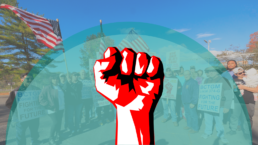Widespread discontent drove labor’s advances in the private sector in 2021
By Tyler Walicek, Truthout
For the labor movement in the United States, 2021 was a year defined by the opening of new fronts. Though embattled and widely disempowered, U.S. workers and union organizers have taken up new mantles. Labor militancy has flared in response to both novel pressures and age-old antagonisms. The unique stressors of the COVID-19 pandemic further destabilized already-fractious arrangements — the grievances of the U.S. working class were mounting long before March 2020, a function of the decades of stagnation and austerity that have been imposed by concentrated private power.
Waves of protests and resignations signaled widespread disenchantment with the exploitative and authoritarian world of work, in a year that was regularly punctuated by organized action: 2021 saw groundbreaking union drives at Amazon and Starbucks, repeated assertions of power by health care workers, prolonged fights at John Deere and Warrior Met Coal, and strikes at Kellogg’s, Nabisco, Frito-Lay and many more. Film and television industry employees, carpenters, teachers, telecom workers, graduate students, video game developers, aerospace engineers — 2021 was remarkable for the diversity of sectors in which the stirrings of collective action either reawakened or arose for the first time.

That said, advances remain tentative. It’s true that this year’s labor struggles played out across an unusually broad array of industries, but this variety belied the comparatively small scope of the 2021 “strike wave,” as it was deemed by many. The number of workers engaged in collective action fell short of the highs of recent years, as did the number of new union election filings. Recalcitrant energies are building, but they have yet to be organized, structured and channeled by a labor movement in which membership rates have long been in precipitous decline.
Recent Posts
Trump Cuts Billions In Federal Childcare Funds For Democratic-Led States After Minnesota Fraud Scandal
January 8, 2026
Take Action Now Administration cites welfare fraud allegations as advocates and state leaders warn of political retaliation and sweeping harm to…
After The ICE Killing In Minneapolis, Will Truth Prevail?
January 8, 2026
Take Action Now Can Trump and Kristi Noem maintain their blatant lies in the face of multiple videos that show the victim was trying to drive away…
Venezuela And The Long Shadow Of The Monroe Doctrine
January 7, 2026
Take Action Now Critical historians like William Appleman Williams played a key role in highlighting the US’s imperial record in Latin America. Now…
President Trump Poses With Sen. Graham And A ‘Make Iran Great Again’ Hat
January 6, 2026
Take Action Now “It’s not politically correct to use the term, ‘Regime Change,’ but if the current Iranian Regime is unable to MAKE IRAN GREAT AGAIN,…




